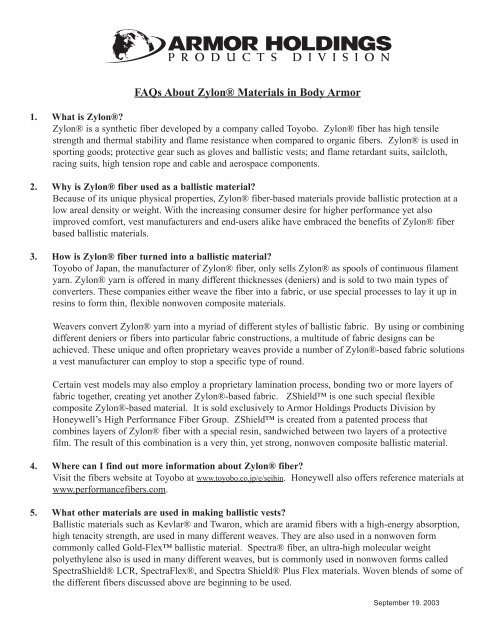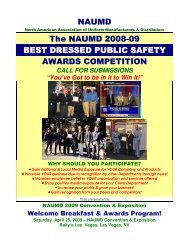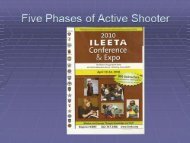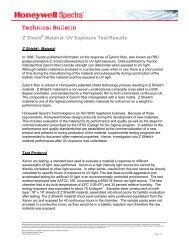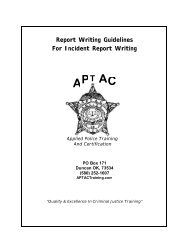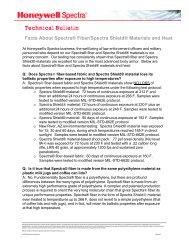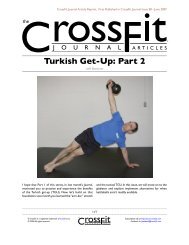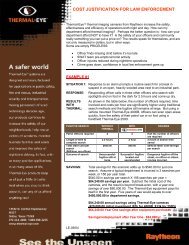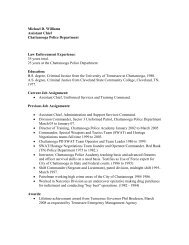FAQs About Zylon® Materials in Body Armor
FAQs About Zylon® Materials in Body Armor
FAQs About Zylon® Materials in Body Armor
You also want an ePaper? Increase the reach of your titles
YUMPU automatically turns print PDFs into web optimized ePapers that Google loves.
<strong>FAQs</strong> <strong>About</strong> Zylon® <strong>Materials</strong> <strong>in</strong> <strong>Body</strong> <strong>Armor</strong>1. What is Zylon®?Zylon® is a synthetic fiber developed by a company called Toyobo. Zylon® fiber has high tensilestrength and thermal stability and flame resistance when compared to organic fibers. Zylon® is used <strong>in</strong>sport<strong>in</strong>g goods; protective gear such as gloves and ballistic vests; and flame retardant suits, sailcloth,rac<strong>in</strong>g suits, high tension rope and cable and aerospace components.2. Why is Zylon® fiber used as a ballistic material?Because of its unique physical properties, Zylon® fiber-based materials provide ballistic protection at alow areal density or weight. With the <strong>in</strong>creas<strong>in</strong>g consumer desire for higher performance yet alsoimproved comfort, vest manufacturers and end-users alike have embraced the benefits of Zylon® fiberbased ballistic materials.3. How is Zylon® fiber turned <strong>in</strong>to a ballistic material?Toyobo of Japan, the manufacturer of Zylon® fiber, only sells Zylon® as spools of cont<strong>in</strong>uous filamentyarn. Zylon® yarn is offered <strong>in</strong> many different thicknesses (deniers) and is sold to two ma<strong>in</strong> types ofconverters. These companies either weave the fiber <strong>in</strong>to a fabric, or use special processes to lay it up <strong>in</strong>res<strong>in</strong>s to form th<strong>in</strong>, flexible nonwoven composite materials.Weavers convert Zylon® yarn <strong>in</strong>to a myriad of different styles of ballistic fabric. By us<strong>in</strong>g or comb<strong>in</strong><strong>in</strong>gdifferent deniers or fibers <strong>in</strong>to particular fabric constructions, a multitude of fabric designs can beachieved. These unique and often proprietary weaves provide a number of Zylon®-based fabric solutionsa vest manufacturer can employ to stop a specific type of round.Certa<strong>in</strong> vest models may also employ a proprietary lam<strong>in</strong>ation process, bond<strong>in</strong>g two or more layers offabric together, creat<strong>in</strong>g yet another Zylon®-based fabric. ZShield is one such special flexiblecomposite Zylon®-based material. It is sold exclusively to <strong>Armor</strong> Hold<strong>in</strong>gs Products Division byHoneywell’s High Performance Fiber Group. ZShield is created from a patented process thatcomb<strong>in</strong>es layers of Zylon® fiber with a special res<strong>in</strong>, sandwiched between two layers of a protectivefilm. The result of this comb<strong>in</strong>ation is a very th<strong>in</strong>, yet strong, nonwoven composite ballistic material.4. Where can I f<strong>in</strong>d out more <strong>in</strong>formation about Zylon® fiber?Visit the fibers website at Toyobo at www.toyobo.co.jp/e/seih<strong>in</strong>. Honeywell also offers reference materials atwww.performancefibers.com.5. What other materials are used <strong>in</strong> mak<strong>in</strong>g ballistic vests?Ballistic materials such as Kevlar® and Twaron, which are aramid fibers with a high-energy absorption,high tenacity strength, are used <strong>in</strong> many different weaves. They are also used <strong>in</strong> a nonwoven formcommonly called Gold-Flex ballistic material. Spectra® fiber, an ultra-high molecular weightpolyethylene also is used <strong>in</strong> many different weaves, but is commonly used <strong>in</strong> nonwoven forms calledSpectraShield® LCR, SpectraFlex®, and Spectra Shield® Plus Flex materials. Woven blends of some ofthe different fibers discussed above are beg<strong>in</strong>n<strong>in</strong>g to be used.September 19. 2003
6. What are the mechanical properties you assess when evaluat<strong>in</strong>g ballistic fibers?You want a good comb<strong>in</strong>ation of the follow<strong>in</strong>g: tensile strength, tensile modulus, elongation, density,moisture retention, impact energy absorption, heat resistance and limit<strong>in</strong>g oxygen <strong>in</strong>dex. We evaluatethese properties with<strong>in</strong> a layer of fabric for weight and flexibility.7. How many different materials do you use <strong>in</strong> your vests?We have dozens of different ballistic fabrics <strong>in</strong> stock that we use for our vest constructions.8. Who supplies your ballistic materials?Honeywell, DuPont, Toyobo, Hexcel, and Barrday are some of our major material suppliers.9. Are all body armor vests made the same way?No. Manufacturers choose the particular ballistic materials they want to use based upon performanceand price. Also the manufactur<strong>in</strong>g process, type of thread and stitch patterns employed and ballisticcover seal used may also be different. The end result is to ensure the ballistic performance conforms tothe NIJ rules. At American <strong>Body</strong> <strong>Armor</strong>, PROTECH and Safariland® we use our own proprietaryresearch and design eng<strong>in</strong>eer<strong>in</strong>g to determ<strong>in</strong>e the right ballistic material, <strong>in</strong> the right spot, for the rightfunction.10. What do you mean by the right material, right spot and right function?Each material has <strong>in</strong>herent strengths and weaknesses dependant upon the threat and target specificationyou need to achieve. Each layer of ballistic fabric is purposefully and sequentially ordered to maximizethe targeted results. The completed “ballistic package” is eng<strong>in</strong>eered to match the threat, whether it beballistic, stab, trauma or any comb<strong>in</strong>ation.11. How do you “eng<strong>in</strong>eer” your ABA, PROTECH and Safariland® vests?We select the best comb<strong>in</strong>ation of ballistic materials to meet the threat required to be matched. Our vestsare eng<strong>in</strong>eered as a hybrid construction. A hybrid construction is one <strong>in</strong> which several different ballisticmaterials are chosen for their particular talents or ballistic performance. Then we layer each fabric <strong>in</strong> aspecific order from the strike face of the vest to the back. These comb<strong>in</strong>ed layers then work together asa team to maximize the performance of that “ballistic package.” Throughout this process we test andretest to ensure the performance of the ballistic package not only meets our own quality standards but theNIJ criteria as well.12. Can ballistic materials degrade <strong>in</strong> use?Yes. It is an <strong>in</strong>dustry recognized fact that the various mechanical properties <strong>in</strong> ballistic materials can,over time, degenerate from their <strong>in</strong>itial performance start<strong>in</strong>g po<strong>in</strong>t. Ballistic material suppliers such asHoneywell, DuPont, Toyobo, etc., aggressively test their ballistic materials <strong>in</strong> extreme heat, cold, andhumidity. In addition, the amount of wear and tear from usage affects material degradation. That is whythe five-year, normal wear cycle vest warranty was established. We anticipate this <strong>in</strong> our vest designsand provide clear care and use guidel<strong>in</strong>es with<strong>in</strong> the owner’s manual for each vest we make.September 19. 2003
13. Is there a report show<strong>in</strong>g Zylon® FIBER degrad<strong>in</strong>g when exposed to a comb<strong>in</strong>ation high heat andhumidity simultaneously?Yes, however it is important to understand the test<strong>in</strong>g and results as they apply to a vest worn on anofficer. Toyobo has rout<strong>in</strong>ely published an ongo<strong>in</strong>g report show<strong>in</strong>g both uncontrolled warehouse andhigh comb<strong>in</strong>ed heat and humidity data from <strong>in</strong>-house test<strong>in</strong>g of the as-produced fiber. The high heat andhumidity condition is generated artificially <strong>in</strong> a special chamber. In the reported data, only the tenacityof the fiber is cited. As mentioned earlier, tenacity is only one of the many properties which contributeto the ballistic response of a material.14. What are the warehouse test<strong>in</strong>g conditions?Toyobo’s warehouse <strong>in</strong> Tsumga, Japan registers an annual temperature range from 26.6º F to a maximumof 98.3º F at an average 70% humidity. Data shows a two to three percent loss <strong>in</strong> the mechanicalproperty of “tenacity” <strong>in</strong> the raw yarn just after the first few days of storage. Toyobo concludes this ispart of the cur<strong>in</strong>g process of the Zylon® yarn. After the <strong>in</strong>itial reduction <strong>in</strong> tenacity, a very slightreduction over time may be observed.15. What do those results mean for the Zylon® yarn shipped to the U.S. for weav<strong>in</strong>g?From the data Toyobo has published it appears that the greatest change <strong>in</strong> tenacity has occurred by thetime we have received the material and hence is already <strong>in</strong>corporated <strong>in</strong>to our vest design.16. When you subject a vest conta<strong>in</strong><strong>in</strong>g Zylon® fabric to test<strong>in</strong>g and also submit it for NIJcertification, is the <strong>in</strong>itial tenacity depletion <strong>in</strong> the raw yarn dur<strong>in</strong>g cur<strong>in</strong>g really a factor?No. We have already eng<strong>in</strong>eered the vest with the various fabric layers so our own test<strong>in</strong>g and also theresults with certification verifies the performance design of that ballistic package.17. What are the conditions of the as-produced Zylon® yarn tested <strong>in</strong> Toyobo’s heat and humiditychamber?Toyobo has placed as-produced Zylon® fiber <strong>in</strong> a chamber that is set to 104ºF and 80% relativehumidity, 24/7, 365 days of the year. The emphasis is on the word “and” because they are <strong>in</strong>tentionallystress<strong>in</strong>g the raw yarn.18. Why is this type of test<strong>in</strong>g used?This type of test<strong>in</strong>g is used as an attempt at “accelerated ag<strong>in</strong>g” but although extreme conditions are usedto simulate ag<strong>in</strong>g, it does not always directly correlate and <strong>in</strong> fact can generate conditions that wouldnever occur <strong>in</strong> a material. For example, if you were to take some of the materials used <strong>in</strong> cloth<strong>in</strong>g andiron them at too high a heat sett<strong>in</strong>g (extreme condition) and they shriveled and scorched, this wouldNOT be simulat<strong>in</strong>g ag<strong>in</strong>g of the material as it could last years if PROPERLY cared for. Similarly,excessive heat <strong>in</strong> a clothes dryer can shr<strong>in</strong>k clothes or ru<strong>in</strong> elastic.19. How do those specific conditions of comb<strong>in</strong>ed heat and humidity relate to our climate <strong>in</strong> the U.S.?It is not realistic. From NASA— “Typically on the planet the highest temperatures occur <strong>in</strong> those placeswhere the soil is dry and the atmosphere conta<strong>in</strong>s little water-desert areas…the drier the soil the less theevaporation, and thus, the higher the maximum temperature and the lower the humidity.” From aNational Weather Service meteorologist: “These conditions are so rare on our planet that the possiblechance of it occurr<strong>in</strong>g might be <strong>in</strong> Calcutta, India, <strong>in</strong> July <strong>in</strong> monsoon season.”September 19. 2003
20. Why did Toyobo choose those extreme conditions?They chose that artificial environment <strong>in</strong> an attempt to simulate advanced ag<strong>in</strong>g of the fibers todeterm<strong>in</strong>e if a ballistic vest would be able to last 10 years when be<strong>in</strong>g worn by an officer. Dur<strong>in</strong>gextreme heat and humidity conditions a process called “hydrolysis” may occur. Hydrolysis is a chemicalreaction <strong>in</strong> which water reacts with a compound to produce other compounds.21. I store my ballistic vest conta<strong>in</strong><strong>in</strong>g Zylon® <strong>in</strong> the trunk of my car when not <strong>in</strong> use. Is this aproblem?Your ballistic vest is a high performance tool, just like your weapon and your duty gear. It should begiven the same care as these other tools. In order to ma<strong>in</strong>ta<strong>in</strong> and protect its optimal ballisticperformance, your ballistic vest should be stored at normal room temperature <strong>in</strong> a dry place. When not<strong>in</strong> use, avoid stor<strong>in</strong>g your ballistic vest <strong>in</strong> places where it is exposed to persistent high temperatures(120ºF and above) <strong>in</strong> comb<strong>in</strong>ation with high humidity (50% and above) for long un<strong>in</strong>terrupted periods oftime (two weeks or more). Ord<strong>in</strong>ary daily temperature and humidity conditions experienced whilewear<strong>in</strong>g your vest dur<strong>in</strong>g rout<strong>in</strong>e shifts will not have an adverse affect on the performance of yourballistic vest. For additional <strong>in</strong>formation see the care and use section of your owner’s manual.22. Is there an <strong>in</strong>dustry standard test that simulates ballistic fiber ag<strong>in</strong>g over ten years? There is no testuniversally agreed upon that can simulate 10 years of ag<strong>in</strong>g. Raw material manufacturers conduct theirown proprietary test<strong>in</strong>g and use field test<strong>in</strong>g and ballistic retest<strong>in</strong>g of their materials when put <strong>in</strong>tofabrics and built <strong>in</strong>to vest designs.23. How does this apply to the Zylon® <strong>in</strong> my vest?First, there is no raw Zylon® fiber <strong>in</strong> your vest. It has been twisted <strong>in</strong>to a yarn which has been wovenand layered <strong>in</strong>to a quilt-like pattern and could even be lam<strong>in</strong>ated. Weav<strong>in</strong>g by itself does not directlychange anyth<strong>in</strong>g around the <strong>in</strong>herent fiber. Twist<strong>in</strong>g of the fiber can <strong>in</strong>crease the tenacity of the fiber.However, the waterproof<strong>in</strong>g, siz<strong>in</strong>g, res<strong>in</strong> and lam<strong>in</strong>ation can and do make changes and improvements tothe fiber.Second, there are many layers <strong>in</strong>corporated <strong>in</strong>to your vest <strong>in</strong> what we call a hybrid construction whichserves to work together with other ballistic layers to maximize performance.Third, your AHPD ballistic package is covered with a polyolef<strong>in</strong> cover that is either heat sealed orwaterproofed. This cover protects the ballistic package from the outside elements, like moisture, the sunand UV.F<strong>in</strong>ally, the high temperature and high relative humidity used <strong>in</strong> Toyobo’s tests is a climatic conditionthat is not naturally found on earth.24. Do you <strong>in</strong>tend to stop us<strong>in</strong>g Zylon®?No. Our quality assurance programs and hybrid construction technology builds upon the strength ofZylon® materials. Zylon® cont<strong>in</strong>ues to offer a performance advantage.September 19. 2003
25. Is AHPD perform<strong>in</strong>g any test<strong>in</strong>g around the Zylon® issue?Test<strong>in</strong>g is an <strong>in</strong>tegral part of our design and development process and cont<strong>in</strong>ues to be important evenafter the body armor from any of our brands is placed <strong>in</strong>to service. We have also periodically testedbody armor from the field. This will be cont<strong>in</strong>ued across all body armor brands and configurations.Our test<strong>in</strong>g of body armor does not <strong>in</strong>dicate performance issues. We will cont<strong>in</strong>ue to conduct test<strong>in</strong>g forproduct performance.26. I’ve seen reports that say that Zylon® fails under heat and humidity. I’ve got a vest with Zylon®and I’m worried!To date the tests we have conducted of Zylon® based vests show no unanticipated degradation <strong>in</strong>ballistic performance. Further, the tests of Zylon® fiber that have been conducted by the manufacturerToyobo and shared with the <strong>in</strong>dustry do not appear to support the conclusion with respect to fiberexposed to normal, everyday conditions.27. When it is 110º outside and I’m sweat<strong>in</strong>g, should I be concerned about degradation to my Zylon®vest?<strong>Body</strong> armor manufactured by American <strong>Body</strong> <strong>Armor</strong>, PROTECH and Safariland® features a ballisticpanel enclosed <strong>in</strong> a water resistant shell to protect it from such conditions. Environmental test<strong>in</strong>gconditions simulated <strong>in</strong> our labs have proven that our hybrid vest meets or exceeds performanceexpectations <strong>in</strong> conditions much more severe than the one <strong>in</strong>dicated above.28. An officer <strong>in</strong> my region says he has a test report from Toyobo stat<strong>in</strong>g that Zylon® has a shr<strong>in</strong>kageissue <strong>in</strong> high temperatures. He is concerned because he stores his tactical vest <strong>in</strong> his trunk.Toyobo consistently supplies us with all test reports regard<strong>in</strong>g their fibers. There is no such report onshr<strong>in</strong>kage of Zylon®. The importance of vest storage cannot be overstressed. This type of improperstorage can affect all ballistic fibers regardless of the fiber or vest manufacturer. We encourage you toreview the owner’s manual provided with each vest.29. Is <strong>Armor</strong> Hold<strong>in</strong>gs Products Division go<strong>in</strong>g to recall vests?No.30. There is a rumor go<strong>in</strong>g around that the US military is pull<strong>in</strong>g all of its Zylon® vests.Most US military organizations are required to buy and use only American made products. Althoughwoven <strong>in</strong> the United States, the Zylon® fiber is currently made <strong>in</strong> Japan, limit<strong>in</strong>g its broad use with<strong>in</strong> theUS military. The Department of Defense has a significant test and evaluation history of many ballisticmaterials and readily advises military users on the performance and expectations of these materials priorto, and dur<strong>in</strong>g body armor procurements. Exam<strong>in</strong>ation of any Zylon®-based armor is at the discretion ofthe Department of Defense; however we are unaware of a broad-based withdrawal of Zylon®-basedarmor.31. Does AHPD make vests that do not conta<strong>in</strong> Zylon®?Absolutely. We have many models to choose from based upon level of protection desired and officer’spreferred comfort needs.September 19. 2003
32. How should I determ<strong>in</strong>e which vest is right for me?First, make sure that the threat level of the vest you choose stops the ammunition that you carry <strong>in</strong> yourown weapon, that of neighbor<strong>in</strong>g departments as well as the threats you are confiscat<strong>in</strong>g on the streets.Be sure the vest is NIJ-approved and from a reputable manufacturer.You’ll also want to consider how you will be wear<strong>in</strong>g it – every day or only as needed – and where youwill have to store the vest. Vest used <strong>in</strong>frequently would need to be properly stored <strong>in</strong> room temperatureconditions to ma<strong>in</strong>ta<strong>in</strong> performance. Other factors such as weight, th<strong>in</strong>ness, flexibility and cost factorsare completely up to the department and/or the <strong>in</strong>dividual officer.33. Where can I f<strong>in</strong>d out more <strong>in</strong>formation about threat level specifications?Contact the National Law Enforcement and Corrections Technology CenterP.O. Box 1160Rockville, MD 20849 – 1160asknlectc.orgwww.nlectc.orgFor more <strong>in</strong>formation about the environmental effects on personal body armor, visitwww.nlectc.org/test<strong>in</strong>g/ba_environment.htmlSeptember 19. 2003


